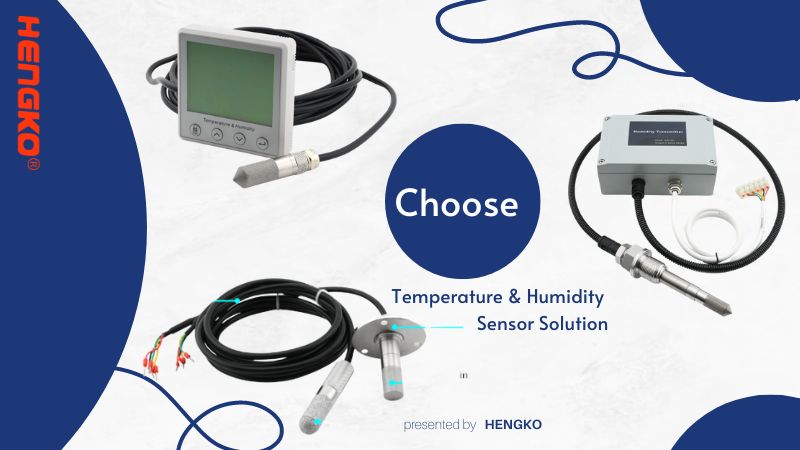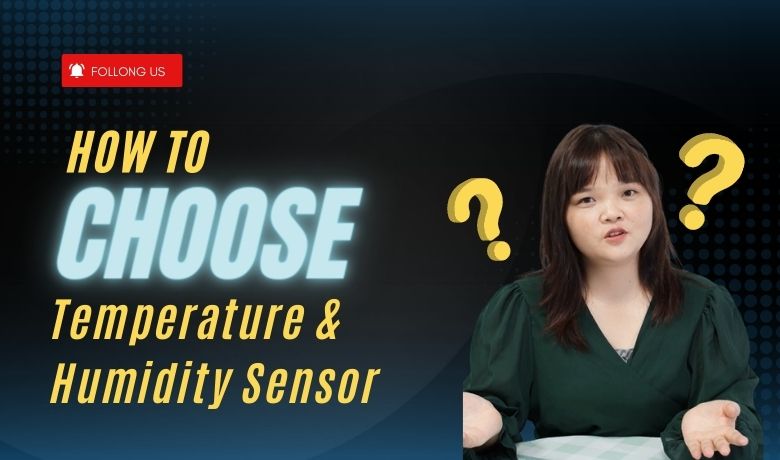How to Choose A Good Temperature and Humidity Sensor and Transmitter?
Choosing the right temperature and humidity sensor can be critical for various applications, such as HVAC systems, agriculture, or indoor air quality monitoring. When selecting a sensor, consider the sensor's accuracy, range, resolution, response time, sensitivity, interface, and cost.
Ensure that the sensor you choose has a high level of accuracy, such as ±2% RH and ±0.5°C, and covers the range of temperatures and humidity levels you need to measure. Look for a sensor with a high resolution for detailed readings and a fast response time for real-time monitoring.
Consider the sensor's sensitivity, as a sensor with high sensitivity may not be suitable for applications with harsh conditions. Also, make sure the interface options offered by the sensor, such as I2C, SPI, or USB, are compatible with the microcontroller or computer you are using.
Then Also, for Industry Applications, Usually, we need to use Temperature and Humidity transmitters.
Here, We Give Some Ideas About How to Choose A Good Temperature and Humidity Transmitter?
Hope It will be helpful for your Choose.
I. Introduction Temperature and humidity transmitters are essential components in various applications, including HVAC systems, laboratory equipment, data centres, greenhouses, and many others. They play a crucial role in monitoring and controlling temperature and humidity levels in these environments, ensuring the comfort, health, and safety of the people and equipment involved. However, choosing the right temperature and humidity transmitter can be challenging, especially for those unfamiliar with the technical aspects involved. This blog aims to help you make an informed decision by highlighting the key factors you should consider when choosing a good temperature and humidity transmitter.
II. Accuracy: One of the most critical aspects to consider when choosing a temperature and humidity transmitter is accuracy. Accurate temperature and humidity readings are essential to ensure the environment is maintained within the desired parameters. The accuracy of a temperature and humidity transmitter is usually expressed in terms of per cent relative humidity (RH) and degrees Celsius (°C) or degrees Fahrenheit (°F). When choosing a temperature and humidity transmitter, look for a device that has a high level of accuracy, typically within 2% RH and ±0.5°C or ±0.9°F.
III. Range: Another important factor to consider is the temperature and humidity transmitter range. The range refers to the maximum and minimum values that the transmitter can measure. It is crucial to choose a temperature and humidity transmitter that has a range that matches your specific requirements. For example, if you want to monitor a data centre's temperature and humidity levels, you may need a device with a range of 0 to 50°C and 0 to 95% RH.
IV. Response Time The response time of a temperature and humidity transmitter refers to the time it takes for the device to provide an accurate reading after a change in temperature or humidity occurs. A fast response time is critical in applications where rapid changes in temperature and humidity can have serious consequences. The response time of a temperature and humidity transmitter is typically measured in milliseconds, and it is essential to choose a device with a response time that meets your specific requirements.
V. Resolution: The resolution of a temperature and
humidity transmitter refers to the smallest increment or decrement detected by the device. A high resolution is essential in applications where precise temperature and humidity control is necessary. For example, in a laboratory setting, a temperature and humidity transmitter with a high resolution is necessary to ensure accurate readings and accurate control of the environment.
VI. Durability is another key factor when choosing a temperature and humidity transmitter. The device must withstand the conditions it will be exposed to and continue to operate accurately and reliably over time. Factors such as temperature extremes, humidity, vibration, and other environmental factors can impact the device's durability. Choosing a temperature and humidity transmitter that is designed to be durable and can withstand the conditions it will be exposed to in your specific application is essential.
VII. Connectivity: Connectivity is an important aspect to consider when choosing a temperature and humidity transmitter. The device should be able to transmit data wirelessly or through a wired connection to a central monitoring system. This allows you to remotely monitor and control the temperature and humidity levels in your environment, giving you more control and flexibility. When choosing a temperature and humidity transmitter, look for a device that offers connectivity options that meet your specific requirements.
VIII. Calibration: Calibration is critical to any temperature and humidity transmitter, as it ensures that the device provides accurate readings. Regular calibration is necessary to maintain the accuracy of the device over time. When choosing a temperature and humidity transmitter, look for a device that offers easy and convenient calibration options, such as on-site calibration or calibration through a computer or mobile device. Choosing a device manufactured by a company that offers ongoing support and maintenance services, such as calibration, repair, and replacement, is also important.
IX. Compatibility: When choosing a temperature and humidity transmitter, it is important to consider compatibility with other components in your system. This includes compatibility with your central monitoring system, as well as compatibility with other temperature and humidity sensors and transmitters. Make sure to choose a temperature and humidity transmitter compatible with your existing systems that can work seamlessly with other components.
X. Cost: The cost is an important factor when choosing a temperature and humidity transmitter. While investing in a high-quality device that meets your specific requirements is essential, it is also important to stay within your budget. When choosing a temperature and humidity transmitter, look for a device that offers the features and capabilities you need at a cost that is affordable and reasonable.
In conclusion, choosing the right temperature and humidity transmitter is essential for monitoring and controlling temperature and humidity levels in various applications. By considering the key factors outlined in this blog, such as accuracy, range, response time, resolution, durability, connectivity, calibration, compatibility, and cost, you can make an informed decision and choose a device that meets your specific requirements and offers reliable and accurate performance over time.
Also Here are Popular FAQs about choosing a good temperature and humidity sensor and transmitter:
1. What is a temperature and humidity sensor and transmitter?
A temperature and humidity sensor and transmitter is a device that measures and transmits temperature and humidity readings to a controller or other data collection device.
2. What factors should I consider when choosing a temperature and humidity sensor and transmitter?
Factors to consider include accuracy, range, response time, calibration, power requirements, and communication protocol.
3. What is the accuracy of a temperature and humidity sensor and transmitter?
Accuracy can vary depending on the type of sensor and the manufacturer. Look for sensors with accuracy of at least ±2% RH and ±0.5°C.
4. What is the range of a temperature and humidity sensor and transmitter?
Range can also vary depending on the sensor and manufacturer. Consider the range of temperatures and humidity levels you need to measure and choose a sensor with a range that covers those values.
5. What is response time and why is it important?
Response time is the time it takes for the sensor to detect and report changes in temperature and humidity. This is important for applications where fast response is critical.
6. Do I need to calibrate my temperature and humidity sensor and transmitter?
Yes, sensors can drift over time and should be calibrated periodically to maintain accuracy.
7. How much power does a temperature and humidity sensor and transmitter require?
Power requirements can vary depending on the type of sensor and communication protocol. Look for sensors with low power consumption to conserve battery life.
8. What communication protocols are available for temperature and humidity sensors and transmitters?
Common protocols include analog voltage or current output, 4-20 mA current loop, RS-485, and I2C.
9. What type of environment will the temperature and humidity sensor and transmitter be used in?
Consider factors such as temperature extremes, humidity levels, and exposure to dust, moisture, or other contaminants when choosing a sensor.
10. What is the cost of a temperature and humidity sensor and transmitter?
Costs can vary depending on the type and features of the sensor. Look for sensors that offer the features you need at a price that fits your budget.
if also you have any questions about temperature and humidity sensor and transmitter and don't know how to Choose humidity sensor and transmitter , you are welcome to Check HENGKO's
humidity sensor and transmitter , Check details to this links: https://www.hengko.com/temperature-and-humidity-transmitter-manufacturer/

Post time: Feb-14-2023





